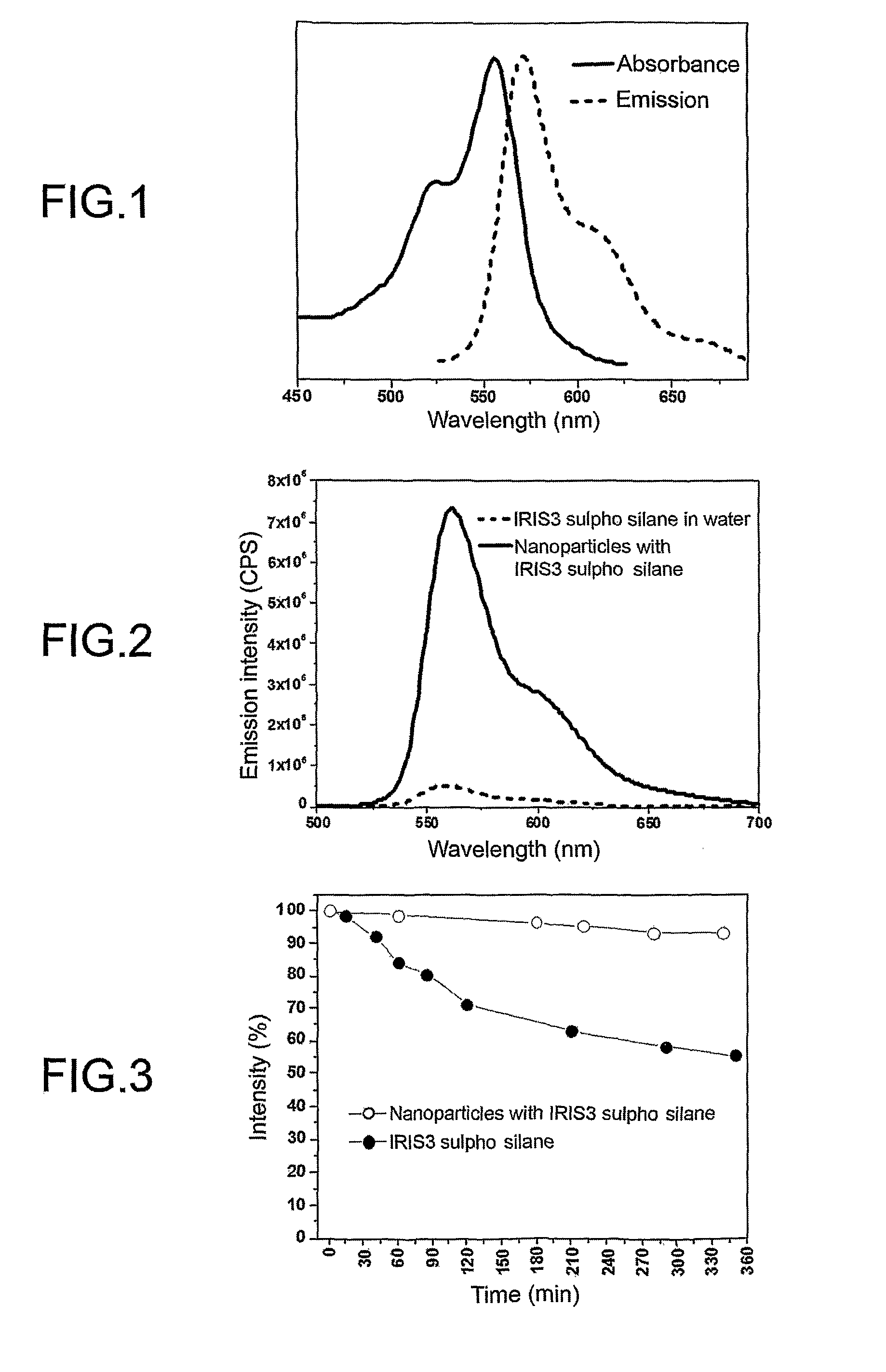Functionalized cyanine having a silane linker arm, a method of preparing thereof and uses thereof
- Summary
- Abstract
- Description
- Claims
- Application Information
AI Technical Summary
Benefits of technology
Problems solved by technology
Method used
Image
Examples
example 1
Synthesis of 1-propyltrimethoxysilane-1′-propyltrimethoxysilane-3,3,3,3′-tetramethyl-5,5′-disulfonate-indomonocarbocyanine potassium salt (IRIS3 sulfo silane) (Compound 1)
a) Synthesis of N-propyltrimethoxysilane-2,3,3-trimethylindoleninium-5-sulfonate
[0089]2,3,3-trimethyl-3H-indolenine-5-sulfonate potassium salt (5 g; 0.02 mol) was dissolved in sulfolane and placed in a round bottom flask, heated in a oil bath at 100° C., equipped with a condenser. When the 2,3,3-trimethyl-3H-indolenine-5-sulfonate potassium salt was completely dissolved, 11.6 g (0.04 mol) of iodopropyltrimethoxysilane were added.
[0090]The reaction mixture was stirred at reflux (100° C.) for 20 hours. The reaction mixture was then cooled at r.t. and added dropwise to 800 ml of diethyl ether. The suspension obtained was filtered and the product recovered on a filter, washed with diethyl ether and dried in vacuum in a desiccator.
b) Synthesis of IRIS3 sulfo silane
[0091]2 g (4.5 mmol) of N-propyltrimethoxysilane-trimeth...
example 2
Synthesis of 1-(5-carboxypentyl)-1′-propyltrimethoxysilane-3,3,3′,3′-tetramethyl-5,5′-disulfonate indodicarbocyanine potassium salt (Compound 2)
a) Synthesis of N-propyltrimethoxysilane-2,3,3-trimethylindoleninium-5-sulfonate
[0094]5 g (0.02 mol) of 2,3,3-trimethyl-3H-indolenine-5-sulfonate potassium salt were dissolved in the lower possible amount of sulfolane and placed in a round bottom flask in a oil bath, pre-heated at 130° C., equipped with a condenser. When the 2,3,3-trimethyl-3H-indolenine-5-sulfonate potassium salt was completely dissolved, 11.6 g (0.04 mol) of iodopropyl-trimethoxysilane were added.
[0095]The reaction mixture was stirred at reflux (100° C.) for 20 hours. The reaction mixture was then cooled at r.t. and added dropwise to 800 ml of diethyl ether. The suspension obtained was filtered and the product recovered on a sinterised glass filter, washed with diethyl ether and dried in vacuum in a desiccator.
b) Synthesis of N-(5-carboxypentyl)-2,3,3-trimethylindoleninium...
example 3
Use of Compound 1 for the Preparation of Photoactive Mesoporous Nanoparticles
a) Preparation of the Mesoporous Material
[0101]The mesoporous material, of the MCM-41 type, was prepared according to the standard procedure disclosed in the literature (T. Mori, Y. Kuroda, Y. Yoshikawa, M. Nagao, S. Kittaka, Langmuir 2002, 18:1595), using cetyl trimethyl ammonium bromide (CTMAB) as the organic template.
b) Functionalization of the mesoporous material with Compound 1
[0102]The mesoporous material (hereafter MCM-41) was pre-treated by outgassing in at 150° C. for at least 4 hours, in order to remove physisorbed water. Then the material was impregnated with a solution of Compound 1 in anhydrous toluene (5 mg Compound 1 per 5 g of MCM-41). The suspension was stirred in Argon atmosphere for two hours. The material was then filtered and washed with solvents in order to remove dye molecules adsorbed on the outer surface of the mesoporous material. The product was then dried in oven at 150° C. (for ...
PUM
| Property | Measurement | Unit |
|---|---|---|
| Size | aaaaa | aaaaa |
| Shape | aaaaa | aaaaa |
Abstract
Description
Claims
Application Information
 Login to View More
Login to View More - R&D
- Intellectual Property
- Life Sciences
- Materials
- Tech Scout
- Unparalleled Data Quality
- Higher Quality Content
- 60% Fewer Hallucinations
Browse by: Latest US Patents, China's latest patents, Technical Efficacy Thesaurus, Application Domain, Technology Topic, Popular Technical Reports.
© 2025 PatSnap. All rights reserved.Legal|Privacy policy|Modern Slavery Act Transparency Statement|Sitemap|About US| Contact US: help@patsnap.com



